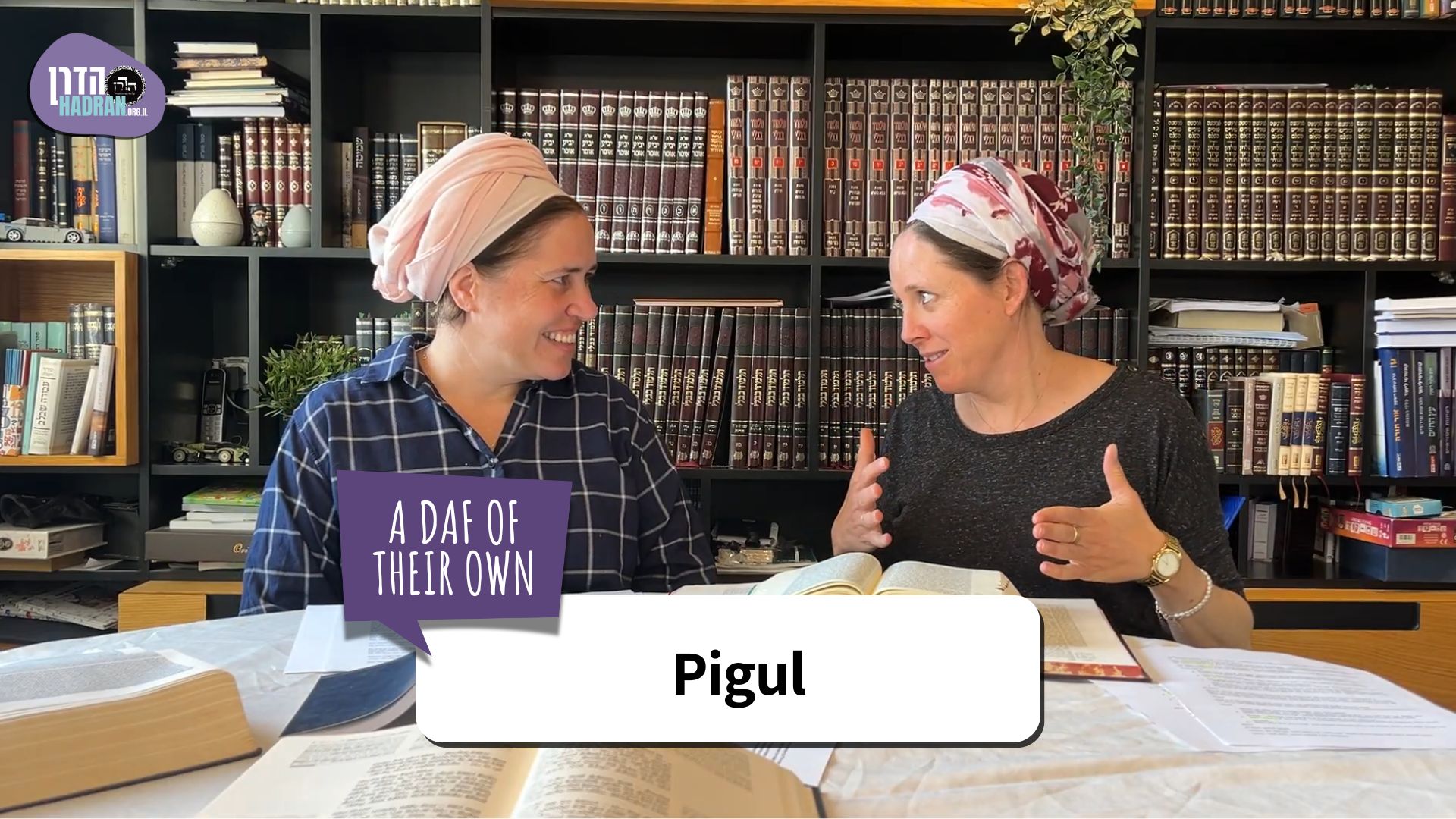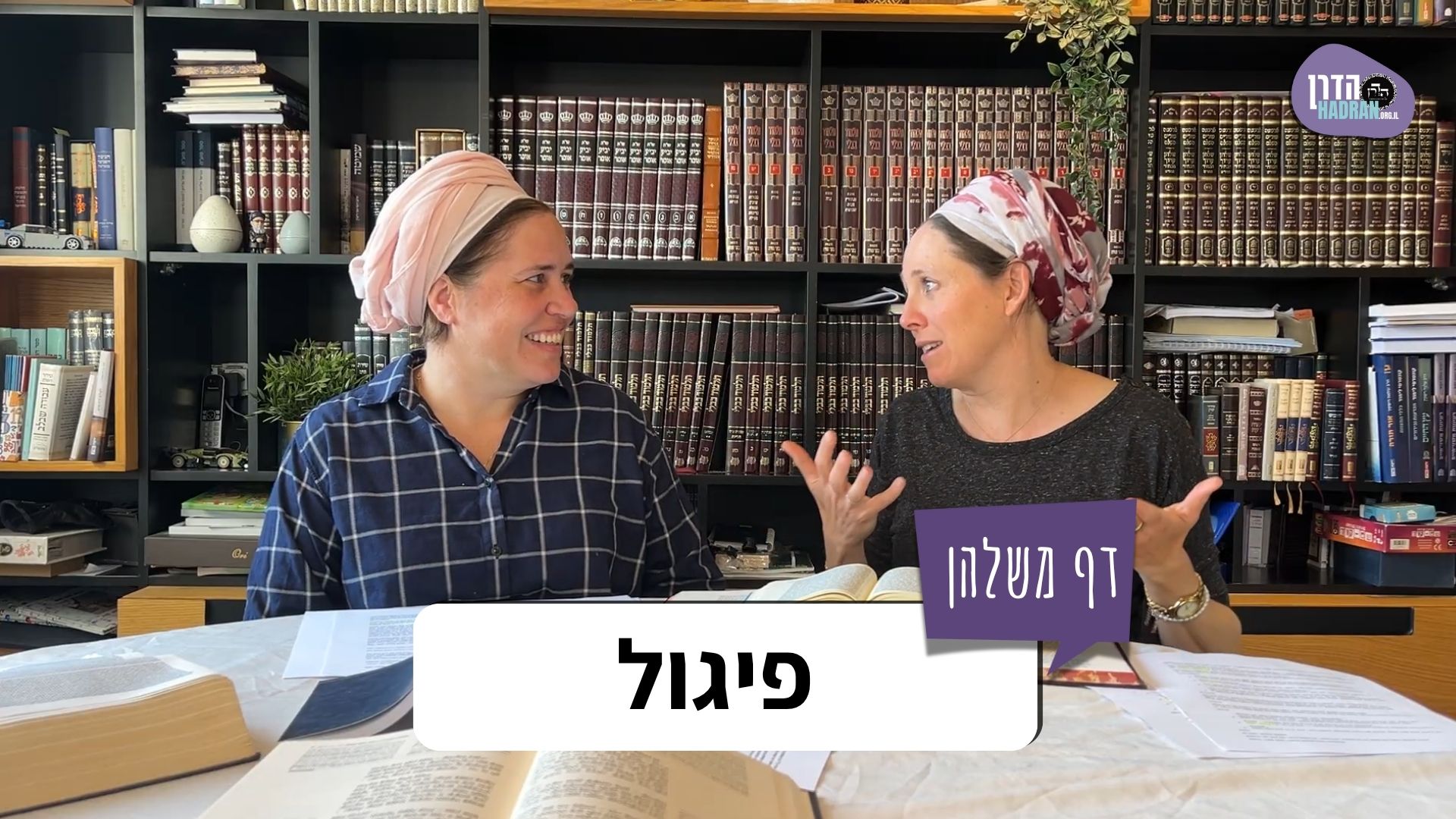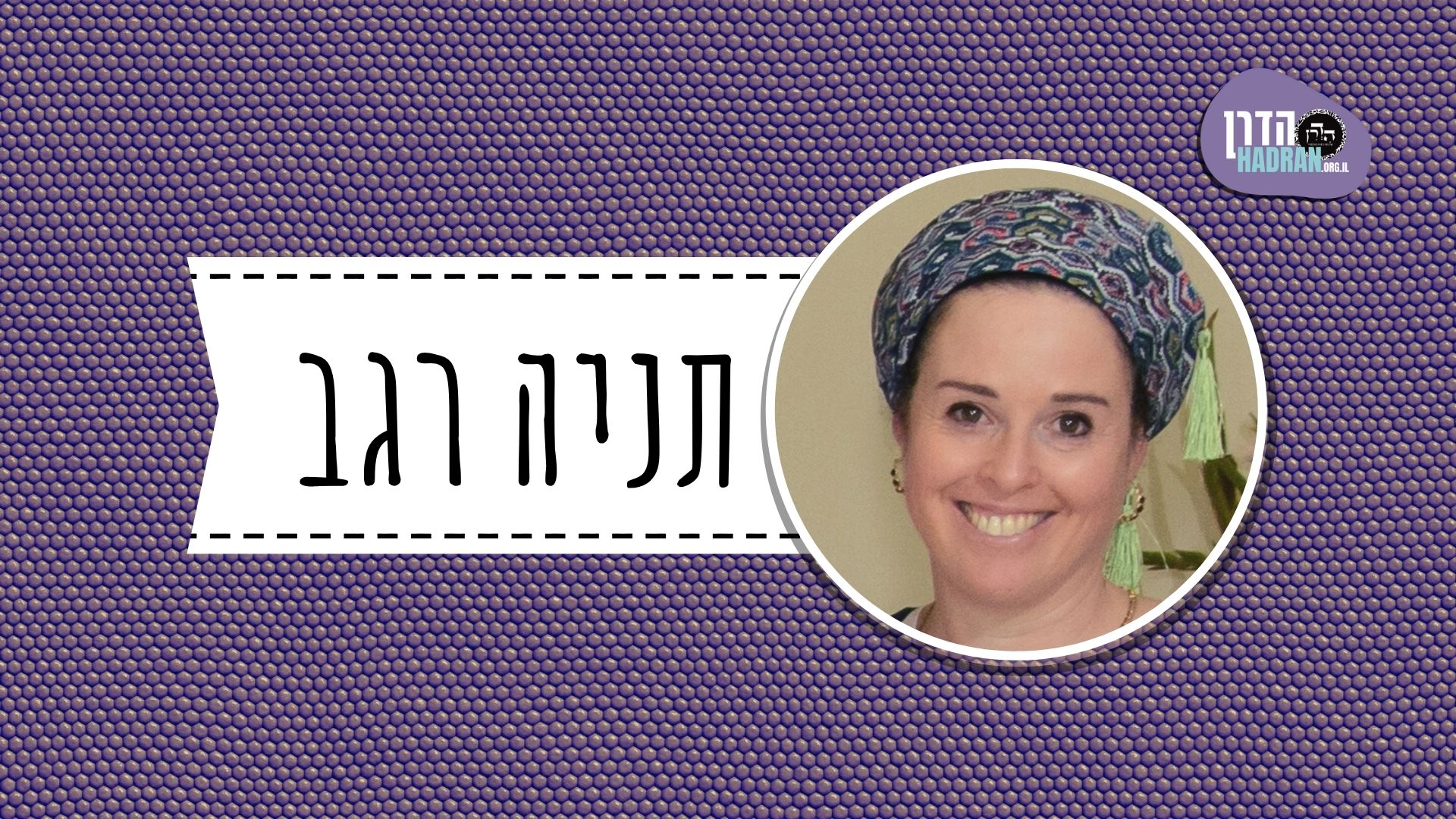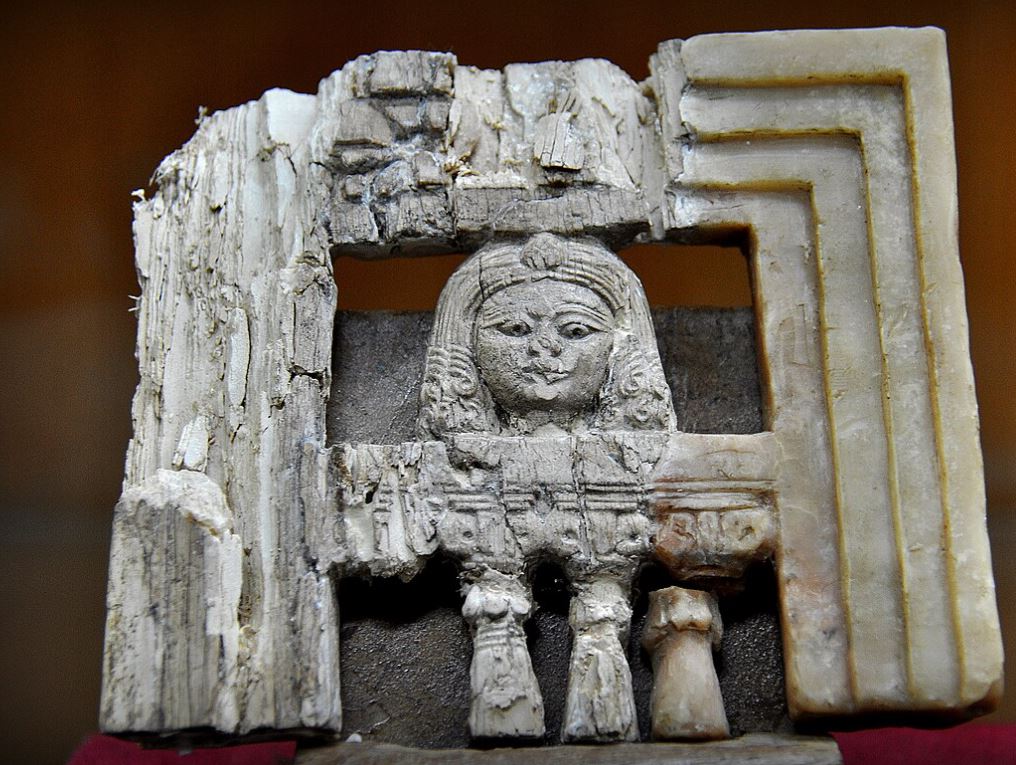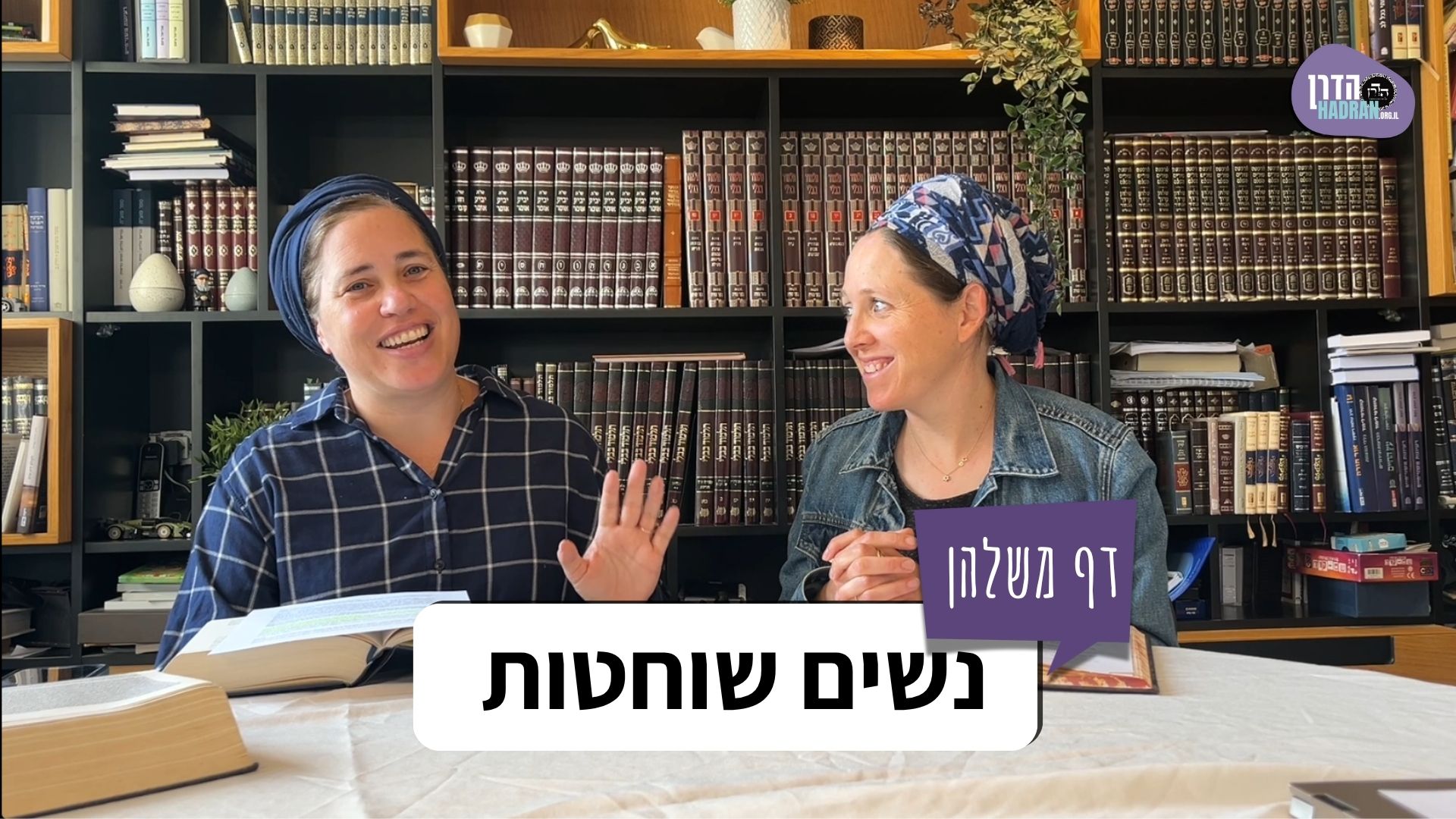מקשים כמה קושיות על שיטת רבי ירמיה שכשחפץ בטל ברוב, אנחנו לא אומרים שהתבטל לגמרי אלא עדיין קיים (חוזר וניעור). כשרואים בהמות מניקות, האם זה ברור שהם מניקים את שלהם או האם יכול להיות שמניקים בהמות שלא שלהם? רב פסק שההלכה ככל המשניות בפרק חוץ מהמקרים שיש בהם מחלוקת. לאיזה משנה/משניות הוא התכוון?
לימוד החודש מוקדש ע”י בט בלקני לכבוד נכדתה, דבורה חנה סרח אייכל.
רוצים להקדיש למידה? התחל כאן:

לימוד החודש מוקדש ע”י בט בלקני לכבוד נכדתה, דבורה חנה סרח אייכל.
העמקה
רוצה להבין מה באמת קורה מתחת לפני השטח של הסוגיה?
שיעורים, פודקאסטים והרחבות של מיטב המורות שלנו יפתחו לך עוד זוויות וכיווני חשיבה.
חדשה בלימוד הגמרא?
זה הדף הראשון שלך? איזו התרגשות עצומה! יש לנו בדיוק את התכנים והכלים שיעזרו לך לעשות את הצעדים הראשונים ללמידה בקצב וברמה שלך, כך תוכלי להרגיש בנוח גם בתוך הסוגיות המורכבות ומאתגרות.
פסיפס הלומדות שלנו
גלי את קהילת הלומדות שלנו, מגוון נשים, רקעים וסיפורים. כולן חלק מתנועה ומסע מרגש ועוצמתי.
בכורות כג
לְרַבִּי אֱלִיעֶזֶר מָה תְּהֵא עֲלֵיהֶן? יֹאכְלוּ נִקּוּדִין, אוֹ קְלָיוֹת, אוֹ יִלּוֹשׁוּ בְּמֵי פֵירוֹת, אוֹ תִּתְחַלֵּק לְעִיסּוֹת, וּבִלְבַד שֶׁלֹּא יְהֵא כְּבֵיצָה בְּמָקוֹם אֶחָד. וְאָמַר עוּלָּא: מָה טַעַם? גְּזֵירָה שֶׁמָּא יָבִיא קַב חוּלִּין טְמֵאִים מִמָּקוֹם אַחֵר וְקַב וְעוֹד מִמִּין זֶה, סָבַר אֱיבַטְּלִינְהוּ בְּרוּבָּא, וְכֵיוָן דְּאִיכָּא הַאי מַשֶּׁהוּ — מָצָא מִין אֶת מִינוֹ וְנֵיעוֹר.
according to Rabbi Eliezer, what will be with them? Let them be eaten dry or roasted, or kneaded with fruit juice, or divided into small batches, provided that there is not an egg-bulk of volume in a single batch. And Ulla says: What is the reason that the mixture may not be allowed to come in contact with water, despite the fact that it is entirely non-sacred? It is a rabbinic decree, lest one bring a kav of non-sacred, impure produce from some other place and take a kav and a little more from this mixture. Then he will think to himself: I will nullify the kav of impure produce with the majority of pure produce from the mixture. But since there is some amount of impure produce in the mixture, the type that was nullified found its own type and is revived in its impure state.
אֲמַר לֵיהּ: אִם טוּמְאָה עוֹרֶרֶת טוּמְאָה, טׇהֳרָה עוֹרֶרֶת טוּמְאָה?
Abaye said to Rav Dimi: That proof is not conclusive. Even if impurity revives impurity, as in the case of teruma where the kav of produce is impure, why should it be assumed that purity revives impurity, as is suggested with regard to the fish brine, where the water in the pot is pure?
אֵיתִיבֵיהּ: אֵפֶר כָּשֵׁר שֶׁנִּתְעָרֵב בְּאֵפֶר מִקְלֶה, הוֹלְכִין אַחַר הָרוֹב לְטַמֵּא, וְאִי רוּבָּא אֵפֶר מִקְלֶה הוּא — לָא מְטַמֵּא. וְאִי אָמְרַתְּ: טוּמְאָה כְּמַאן דְּאִיתֵיהּ דָּמֵי, נְהִי דִּבְמַגָּע לָא מְטַמֵּא — לְטַמֵּא בְּמַשָּׂא!
Abaye raised an objection to the opinion of Rabbi Yirmeya from a mishna (Para 9:7): If the ashes of a red heifer, which impart ritual impurity to the priests involved in its ritual and are fit for sprinkling on someone impure with impurity imparted by a corpse, became intermingled with regular burned ashes, we follow the majority in order to determine whether or not the mixture is impure. And therefore, if the majority is composed of the regular burned ashes, the mixture does not impart impurity. Abaye explains the objection: And if you say nullified impurity is considered like an item that is nevertheless present in the mixture and can be revived, then although the mixture does not impart impurity through physical contact as it is assumed that one touches the majority, let it impart impurity through carrying due to the ashes of the red heifer.
הָא אִיתְּמַר עֲלַהּ, אָמַר רַבִּי יוֹסֵי בְּרַבִּי חֲנִינָא: טָהוֹר מִלְּטַמֵּא בְּמַגָּע, אֲבָל מְטַמֵּא בְּמַשָּׂא.
Rav Dimi responded: In fact, it was stated with regard to that mishna that Rabbi Yosei, son of Rabbi Ḥanina, says: The mixture is pure in the sense that it does not impart impurity through contact, but it does impart impurity through carrying.
וְהָאָמַר רַב חִסְדָּא: נְבֵילָה בְּטֵילָה בִּשְׁחוּטָה, שֶׁאִי אֶפְשָׁר לִנְבֵילָה שֶׁתֵּיעָשֶׂה שְׁחוּטָה. נְהִי דִּבְמַגָּע לָא מְטַמֵּא, לְטַמֵּא בְּמַשָּׂא!
Abaye responded: But doesn’t Rav Ḥisda say: If meat from an animal carcass, which imparts ritual impurity, was mixed with the meat of a slaughtered animal, the meat from the carcass is nullified by the meat of the slaughtered animal in the event that the ritually pure meat constitutes a majority. The reason is that it is impossible for a carcass to become a slaughtered animal, i.e., a ritually slaughtered animal can never have the status of a carcass with regard to impurity. Abaye explains the difficulty: Granted that it does not impart impurity through contact, but if the impurity is considered present to some extent let the mixture impart impurity through carrying.
אֲמַר לֵיהּ: אַתּוּן בִּדְרַב חִסְדָּא מַתְנִיתוּ לַהּ, אֲנַן בִּדְרַבִּי חִיָּיא מַתְנֵינַן לַהּ. תָּנֵי רַבִּי חִיָּיא: נְבֵילָה וּשְׁחוּטָה בְּטֵילוֹת זוֹ בָּזוֹ, וְאִיתְּמַר עֲלַהּ, אָמַר רַבִּי יוֹסֵי בְּרַבִּי חֲנִינָא: טָהוֹר מִלְּטַמֵּא בְּמַגָּע, אֲבָל מְטַמֵּא בְּמַשָּׂא.
Rav Dimi said to Abaye: You learned the mishna according to the interpretation of Rav Ḥisda, but we learned it according to the interpretation of Rabbi Ḥiyya, as Rabbi Ḥiyya teaches: With regard to meat from an animal carcass and meat from a slaughtered animal, one nullifies the other, depending on the majority. And it was stated with regard to this ruling that Rabbi Yosei, son of Rabbi Ḥanina, says: If the majority is from a slaughtered animal the mixture is pure in the sense that it does not impart impurity through contact, but it does impart impurity through carrying.
וְהָא דִּתְנַן: רַבִּי אֱלִיעֶזֶר בֶּן יַעֲקֹב אוֹמֵר: בְּהֵמָה גַּסָּה שֶׁשָּׁפְעָה חֲרָרַת דָּם — הֲרֵי זוֹ תִּקָּבֵר, וְנִפְטְרָה מִן הַבְּכוֹרָה. וְתָנֵי רַבִּי חִיָּיא: אֵינָהּ מְטַמְּאָה לֹא בְּמַגָּע וְלֹא בְּמַשָּׂא. אַמַּאי? דִּנְהִי בְּמַגָּע לָא מְטַמֵּא, תְּטַמֵּא בְּמַשָּׂא! אִישְׁתִּיק.
Abaye raised another difficulty: And that which we learned in our mishna contradicts your opinion, as Rabbi Eliezer ben Yaakov says: In the case of a large animal that expelled a mass of congealed blood, that mass must be buried, and the animal is exempt from having any future offspring counted a firstborn. And Rabbi Ḥiyya teaches with regard to this ruling: That mass does not impart ritual impurity, neither through physical contact nor through carrying. But why? If Rav Dimi is correct, then granted it does not impart impurity through contact, but let it nevertheless impart impurity through carrying. Rav Dimi was silent in response.
דִּלְמָא, וַדַּאי שָׁאנֵי הָכָא, דְּהָוְיָא לַהּ טוּמְאָה סְרוּחָה. הָנִיחָא לְבַר פְּדָא, דְּאָמַר: טוּמְאָה חֲמוּרָה עַד לְגֵר, וְטוּמְאָה קַלָּה עַד לְכֶלֶב, הָא לָא חַזְיָא לְגֵר. אֶלָּא לְרַבִּי יוֹחָנָן דְּאָמַר:
The Gemara asks: Why was Rav Dimi silent? Perhaps the halakha is different here, as it is decayed impurity, since an animal carcass that has rotted does not impart impurity at all. The Gemara comments: This works out well according to the opinion of bar Padda, who says: An item with severe ritual impurity, such as that of a nonviable newborn, imparts impurity to substances until it is rotted to the degree that it is no longer fit to be consumed by a gentile who observes certain mitzvot [ger toshav], who is permitted to consume it; but an item with light impurity, which transmits impurity only by contact, imparts impurity to substances until it is no longer fit to be eaten by a dog. And as this congealed mass is not fit to be eaten by a ger toshav it does not impart impurity. But according to Rabbi Yoḥanan, who says:
אַחַת זוֹ וְאַחַת זוֹ עַד לְכֶלֶב, הָא חַזְיָא לְכֶלֶב! קַשְׁיָא.
Both this one and that one, i.e., items of both forms of impurity, impart impurity until they are no longer fit to be eaten by a dog, it poses a difficulty to the opinion of Rabbi Yirmeya, as this mass is fit for a dog. The Gemara concludes: Indeed, it is difficult.
גּוּפָא, בַּר פְּדָא אָמַר: טוּמְאָה חֲמוּרָה עַד לְגֵר, וְטוּמְאָה קַלָּה עַד לְכֶלֶב. וְרַבִּי יוֹחָנָן אָמַר: אַחַת זוֹ וְאַחַת זוֹ עַד לְכֶלֶב. מַאי טַעְמָא דְּבַר פְּדָא? דִּכְתִיב: ״לֹא תֹאכְלוּ כׇל נְבֵלָה לְגֵר וְגוֹ׳״, הָרְאוּיָה לַגֵּר קְרוּיָה ״נְבֵילָה״, וְשֶׁאֵינָהּ רְאוּיָה לַגֵּר אֵינָהּ קְרוּיָה ״נְבֵילָה״.
The Gemara discusses the matter itself. Bar Padda says: An item with severe ritual impurity imparts impurity to substances until it is no longer fit to be eaten by a ger toshav, but an item with light impurity imparts impurity to substances until it is no longer fit to be eaten by a dog. And Rabbi Yoḥanan says: Both this one and that one impart impurity until they are no longer fit to be eaten by a dog. The Gemara asks: What is the reason for the ruling of bar Padda? As it is written: “You shall not eat of any animal carcass; you may give it to the ger who is within your gates” (Deuteronomy 14:21). Bar Padda understands from this verse that an item which is fit for a ger toshav is called an animal carcass, and that which is not fit for a ger toshav is not called an animal carcass.
וְאִידַּךְ? לְמַעוֹטֵי הֵיכָא דְּהִסְרִיחָה מֵעִיקָּרָא. וְאִידַּךְ? הִסְרִיחָה מֵעִיקָּרָא לָא צְרִיכָא קְרָא לְמַעוֹטֵי, עַפְרָא בְּעָלְמָא הוּא.
The Gemara asks: And with regard to the other Sage, Rabbi Yoḥanan, how does he interpret that verse? He maintains that it serves to exclude a carcass that was decayed from the outset, e.g., if the flesh started to decompose while the animal was still alive, due to severe injury. But if the carcass was initially edible and later decayed, it continues to impart ritual impurity provided it is fit for a dog. The Gemara asks: And with regard to the other Sage, bar Padda, how does he respond to this claim? A verse is not necessary to exclude such a case where the carcass was decayed from the outset, as it is merely like dust and obviously does not impart impurity.
תְּנַן: רַבִּי אֱלִיעֶזֶר בֶּן יַעֲקֹב אוֹמֵר: בְּהֵמָה גַּסָּה שֶׁשָּׁפְעָה חֲרָרַת דָּם, הֲרֵי זוֹ תִּקָּבֵר, וְנִפְטֶרֶת מִן הַבְּכוֹרָה. וְתָנֵי רַבִּי חִיָּיא: אֵינָהּ מְטַמְּאָה לֹא בְּמַגָּע וְלֹא בְּמַשָּׂא. וְאָמַר רַבִּי יוֹחָנָן: מִשּׁוּם בִּיטּוּל בְּרוֹב נָגְעוּ בָּהּ.
We learned in our mishna that Rabbi Eliezer ben Ya’akov says: In the case of a large animal that expelled a mass of congealed blood, that mass must be buried, and the animal is exempt from having any future offspring counted a firstborn. And Rabbi Ḥiyya teaches: That mass of congealed blood does not impart ritual impurity, neither through physical contact nor through carrying. And Rabbi Yoḥanan says: It is due to the halakhic nullification of a forbidden substance in a majority of permitted substances that the Sages touched upon it, in order to exclude it from impurity through contact or carrying.
מַאי אִירְיָא מִשּׁוּם בִּיטּוּל בְּרוֹב? תִּיפּוֹק לִי דְּלָא אִיתְחֲזִי כְּלָל! הָא נָמֵי אִיתְחֲזִי מֵעִיקָּרָא אַגַּב אִימֵּיהּ.
The Gemara asks: Why did Rabbi Yoḥanan say this halakha is due specifically to the nullification of a substance in a mixture by the majority of the mixture? Let one derive the halakha from the fact that the mass is not fit for consumption at all, and it never was. The Gemara explains: This too was initially fit by virtue of its mother, i.e., if one had slaughtered the mother before the embryo was discharged it would have been edible as part of the mother.
תְּנַן הָתָם: רַבִּי אֱלִיעֶזֶר בֶּן יַעֲקֹב אוֹמֵר: צִיר טָהוֹר שֶׁנָּפַל לְתוֹכוֹ מַיִם כׇּל שֶׁהוּא — טָמֵא. אָמַר רַב נַחְמָן אָמַר רַבָּה בַּר אֲבוּהּ: זֹאת אוֹמֶרֶת נֶחְשְׁדוּ עַמֵּי הָאָרֶץ לְעָרֵב מֶחֱצָה בַּצִּיר. וּלְמָה לִי מֶחֱצָה? אֲפִילּוּ בְּצִיר מִמֶּחֱצָה נָמֵי! וְהָנֵי מַשֶּׁהוּ — הָוֵה לֵיהּ פַּלְגָא, וּפַלְגָא לָא בְּטִיל.
We learned in a mishna elsewhere (Makhshirin 6:3) that Rabbi Eliezer ben Yaakov says: Ritually pure brine, taken from an am ha’aretz, into which any amount of water fell is rendered impure. Rav Naḥman says that Rabba bar Avuh says: That is to say that amei ha’aretz are suspected of mixing half a portion of water in the brine, which means that when the additional water falls in, the nullified impurity in the brine is revived by it and renders the entire mixture impure. The Gemara asks: But why do I need to say they are suspected of mixing precisely half a portion of water? Even if they mix in less than half, the brine will also be rendered impure upon contact with the added water, as that small amount combined with slightly less than half a portion of water constitutes half the mixture, and half a mixture is not nullified by the other half.
אֵימָא: עַד מֶחֱצָה. אִיבָּעֵית אֵימָא: טוּמְאַת עַם הָאָרֶץ דְּרַבָּנַן, טוּמְאַת מַשְׁקִין דְּרַבָּנַן. בְּרוּבָּא גְּזַרוּ רַבָּנַן, בְּפַלְגָא וּפַלְגָא לָא גְּזַרוּ בַּהּ רַבָּנַן.
The Gemara answers: Say instead that an am ha’aretz is suspected of mixing in water until it constitutes slightly less than half the mixture. And if you wish, say instead: The impurity of foods belonging to an am ha’aretz applies by rabbinic law and the impurity of liquids also applies by rabbinic law. Accordingly, the impurity of the brine in this case is due to two separate rabbinic decrees. Where the majority is water the Sages decreed the brine is impure, but in a case where half the mixture is pure fish brine and half is water the Sages did not decree that the brine is impure.
מַתְנִי׳ רַבָּן שִׁמְעוֹן בֶּן גַּמְלִיאֵל אוֹמֵר: הַלּוֹקֵחַ בְּהֵמָה מְנִיקָה מִן הַגּוֹי — אֵין חוֹשְׁשִׁין שֶׁמָּא בְּנָהּ שֶׁל אַחֶרֶת הָיָה. נִכְנָס לְתוֹךְ עֶדְרוֹ וְרָאָה אֶת הַמַּבְכִּירוֹת מְנִיקוֹת, וְשֶׁאֵינָן מַבְכִּירוֹת מְנִיקוֹת — אֵין חוֹשְׁשִׁין שֶׁמָּא בְּנָהּ שֶׁל זוֹ בָּא לוֹ אֵצֶל זוֹ, אוֹ שֶׁמָּא בְּנָהּ שֶׁל זוֹ בָּא לוֹ אֵצֶל זוֹ.
MISHNA: Rabban Shimon ben Gamliel says: In the case of one who purchases a nursing female animal from a gentile, he does not need to be concerned, i.e., take into account the possibility, that perhaps it was nursing the offspring of another animal. Rather, the buyer may assume it had previously given birth. In the case of one who enters amid his flock and sees mother animals that gave birth for the first time that were nursing, and also sees mother animals that gave birth not for the first time that were also nursing, he does not need to be concerned that perhaps the offspring of this animal came to that animal to be nursed, or that perhaps the offspring of that animal came to this animal to be nursed.
גְּמָ׳ אָמַר רַב נַחְמָן מִשְּׁמֵיהּ דְּרַב: הִלְכְתָא בְּכוּלֵּיהּ פִּירְקִין, בַּר מִפְּלוּגְתָּא. אָמַר רַב שֵׁשֶׁת: אָמֵינָא כִּי נָיֵים וְשָׁכֵיב רַב אָמַר לְהָא שְׁמַעְתָּא! אַהֵיָיא? אִילֵּימָא אַרֵישָׁא — (מפליגי) [מִיפְלָג פְּלִיגִי] רַבִּי יִשְׁמָעֵאל וְרַבִּי עֲקִיבָא!
GEMARA: Rav Naḥman said in the name of Rav: The halakha is in accordance with the opinion of the anonymous tanna in the mishnayot throughout the whole chapter, except where there is a difference of opinion recorded in that mishna. Rav Sheshet says: I say Rav was dozing or sleeping when he said this halakha. After all, to which mishna is this referring? If we say it is referring to the first mishna in the chapter (19b) then his ruling does not apply, as Rabbi Yishmael and Rabbi Akiva disagree in that mishna.
אֶלָּא אַדְּרַבִּי אֱלִיעֶזֶר בֶּן יַעֲקֹב — מִשְׁנַת רַבִּי אֱלִיעֶזֶר בֶּן יַעֲקֹב ״קַב וְנָקִי״.
Rather, you will say it is referring to the ruling of Rabbi Eliezer ben Yaakov (21b). This is also problematic, since it is already known that the halakha is in accordance with his opinion, as there is an established principle that the teaching of Rabbi Eliezer ben Ya’akov measures only a kav but is clean and accurate, and therefore the halakha is in accordance with his opinions.
אֶלָּא אַדְּרַבָּן שִׁמְעוֹן בֶּן גַּמְלִיאֵל מִפְלָג פְּלִיג בְּבָרַיְיתָא! אֶלָּא אַדְּרַבִּי יוֹסֵי בֶּן הַמְשׁוּלָּם — הָא אָמַר רַב חֲדָא זִימְנָא, דְּאָמַר רַב: הִלְכְתָא כְּרַבִּי יוֹסֵי בֶּן הַמְשׁוּלָּם! אֶלָּא אַשְּׂעַר בַּעַל מוּם מִיפְלָג פְּלִיגִי עֲקַבְיָא בֶּן מַהֲלַלְאֵל וְרַבָּנַן!
Rather, you will say it is referring to the statement of Rabban Shimon ben Gamliel in the mishna here. That is also difficult, as there is a tanna who disagrees, in the baraita cited on 24a. Rather, you will say that it is referring to the statement of Rabbi Yosei ben HaMeshullam in the next mishna (24b). But didn’t Rav already say this one time? As Rav said: The halakha is in accordance with the opinion of Rabbi Yosei ben HaMeshullam. Rather, you will say that it is referring to the matter of the hair of a blemished firstborn discussed in the mishna on 25b. But that case too is subject to a dispute, as Akavya ben Mahalalel and the Rabbis disagree in that mishna.
לְעוֹלָם אַדְּרַבָּן שִׁמְעוֹן בֶּן גַּמְלִיאֵל, וְהָא קָא מַשְׁמַע לַן: דְּבָרַיְיתָא לָא פְּלוּגְתָּא הִיא.
The Gemara answers: Actually, Rav’s statement is referring to the statement of Rabban Shimon ben Gamliel here, and Rav teaches us this: That if a mishna is contradicted by a dissenting opinion cited in a baraita it is not considered a dispute, and the halakha therefore follows the opinion of Rabban Shimon ben Gamliel.
וְכֵיוָן דְּאָמַר רַב: הִלְכְתָא בְּכוּלֵּיהּ פִּירְקִין בַּר מִפְּלוּגְתָּא,
The Gemara asks: But once Rav said the halakha is in accordance with the opinion of the anonymous tanna in the mishnayot throughout the whole chapter except where there is a difference of opinion,
